Retro Review: Toshiba Satellite 4010CDT
12th February 2024
Introduction
Back in 2018, I was on the hunt for a decent retro laptop PC best suited to running Windows 98 games. During the search I gathered a lot of information on the pros and cons of the various laptop technologies and what makes and models would be a solid all-rounder for gaming in this era. By their very nature, expansion options are limited for laptops - you can usually upgrade the RAM and increase the hard disk capacity, but whichever model you choose, you're usually stuck with the CPU and certainly the display that it came with.
I ended up buying three laptops over the course of about a year, and for this month's Retro Review, we're going to take a look at the most recent of them - a Toshiba Satellite 4010CDT. It's a nice small unit in both width and depth, though as per it's 1999 heritage, is rather a brick when you look at its height (something you just need to accept - it was normal back then).
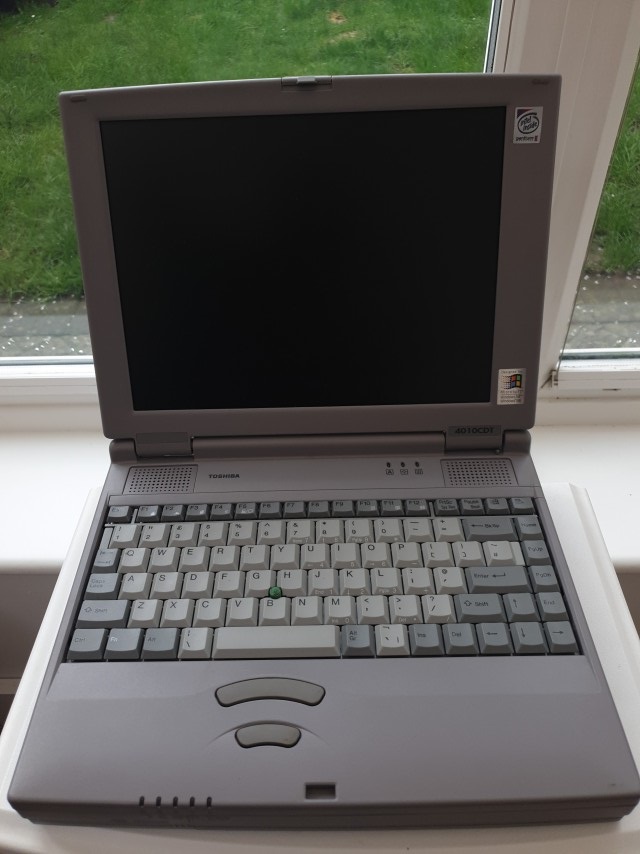 |
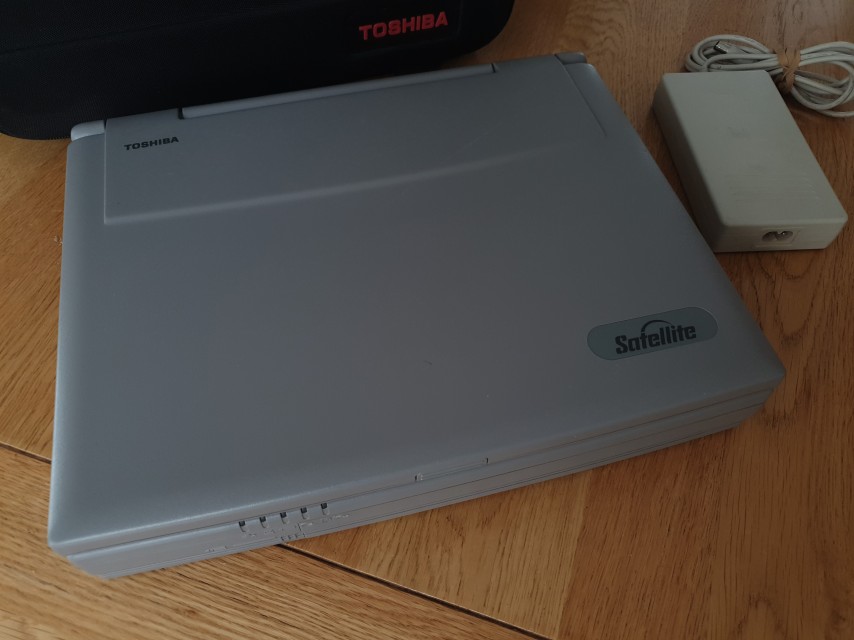 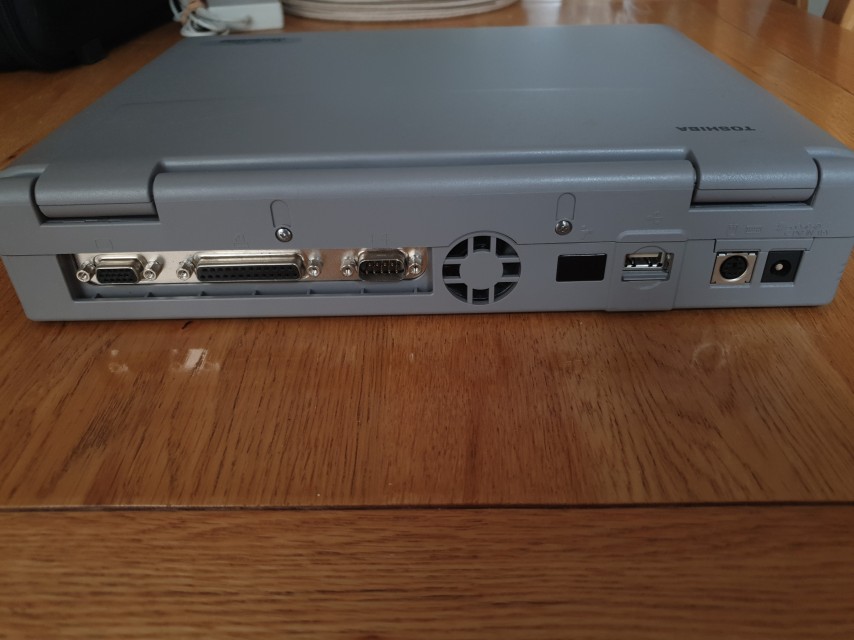 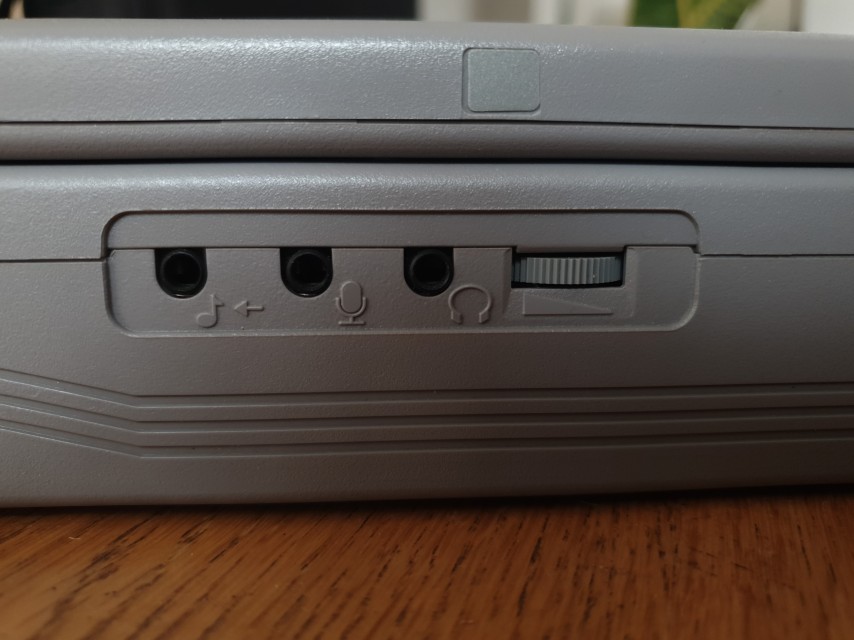 |
The Satellite 4010CDT was launched in 1999 and comprised two models - the 4010CDS and 4010CDT. Both of these were identical apart from the type of display technology used. The CDS was the worse of the two, coming with a passive matrix dual-scan (DSTN) LCD, which Toshiba called "Color Bright Dual Scan", while the CDT used an active matrix TFT LCD. Both of these were 12.1" diagonal and supported a native resolution of 800 x 600.
The base specifications of the Toshiba Satellite 4010 range looks like this:
- Intel Mobile Pentium II "Tonga" CPU running at 266 MHz, with 32 KB L1 cache and 512 KB L2 cache.
- Intel 440BX chipset running on a 66 MHz Front Side Bus.
- 32 MB SDRAM, expandable to 160 MB.
- Chips & Technologies CT65555 64-bit PCI video controller with 2 MB of video memory (Direct3D-compatible).
- 3.8 GB hard drive (Ultra DMA Model 2 providing up to 33.3 MB/sec throughput).
- Internal 3.5" 1.44 MB DS/HD floppy drive.
- Internal 24x CD-ROM drive.
- Yamaha OPL3-SA3 sound card (Sound Blaster Pro and Windows Sound System-compatible, with 3D effects).
- 3Com Noteworthy 56Kbps PCMCIA modem.
- A plethora of ports including 1 x 9-pin RS232 serial port, 1 x 25-pin parallel port, 15-pin DSUB video output, IrDA infrared, PS/2 port, 1 x USB 1.0 port, PC Card slot (2 x Type II or 1 x Type III), and audio jacks for mic, headphone, and line-in.
These laptops came bundled with Windows 98 and a bundle of other supporting applications / utilities including Yamaha Audio Rack, Symantec Anti Virus Scanner 4.0, Mediamatics Arcade Pak, the Windows 98 Companion CD, and more.
The 4010 models were at the budget end of Toshiba's laptop offerings for January 1999. The full range at the time can be seen in the table below:
| Model | CPU | Memory | Display | Price |
|---|---|---|---|---|
| 4010CDS | Pentium II 266 MHz | 32 MB | 12.1" DSTN | $1,399 |
| 4010CDT | Pentium II 266 MHz | 32 MB | 12.1" TFT | $1,899 |
| 4020CDT | Pentium II 300 MHz | 64 MB | 13.3" TFT | $2,499 |
| 4080XCDT | Pentium II 366 MHz | 64 MB | 14.1" TFT | $3,199 |
The Component Parts
The Mobile Pentium II
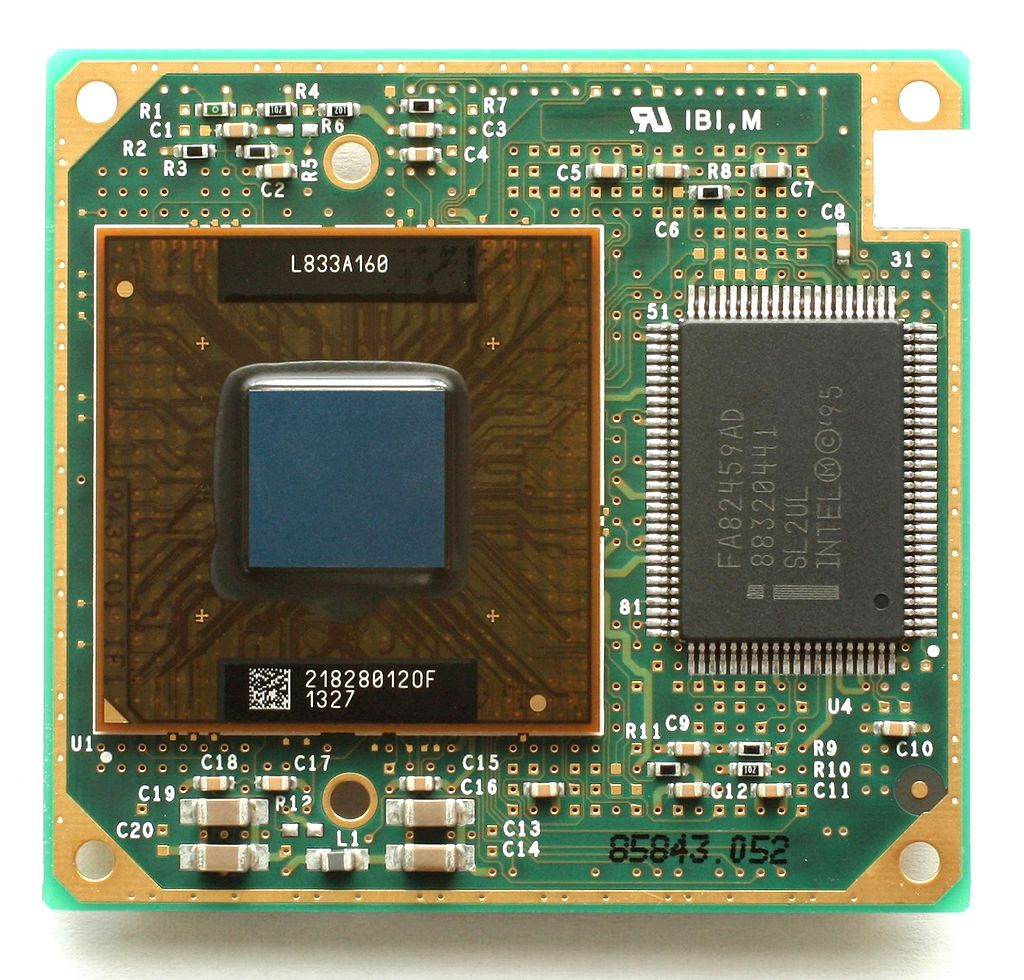 Released almost one year after Intel launched the first desktop Pentium II in May 1997 in its 'Slot 1' desktop format (codenamed "Klamath"), the first variant designed for the mobile market arrived. Intel had managed to get their 250nm manufacturing process running by April 1998, and produced a faster desktop Pentium II ("Deschutes"), and the first mobile Pentium II ("Tonga"). Both of these were essentially the same, but while Deschutes ran with a core voltage of 2.0V, Tonga ran at a reduced 1.6V. Both included MMX instructions and supported 66 MHz front side bus speeds, though the desktop variant could also run on 100 MHz.
Released almost one year after Intel launched the first desktop Pentium II in May 1997 in its 'Slot 1' desktop format (codenamed "Klamath"), the first variant designed for the mobile market arrived. Intel had managed to get their 250nm manufacturing process running by April 1998, and produced a faster desktop Pentium II ("Deschutes"), and the first mobile Pentium II ("Tonga"). Both of these were essentially the same, but while Deschutes ran with a core voltage of 2.0V, Tonga ran at a reduced 1.6V. Both included MMX instructions and supported 66 MHz front side bus speeds, though the desktop variant could also run on 100 MHz.
Tonga was given the branding "Mobile Pentium II" in advertisements, and was packaged in Intel's new "MMC-1" cartridge format. It was produced in clocks speeds of 233 MHz, 266 MHz and 300 MHz.
The design of the Pentium II was a bit of a stepping stone in terms of its cache design. Intel wanted to get a performance gain from the Level 2 cache that was now commonplace on motherboards, by bringing it much closer to the CPU. This was first seen in the Klamath Pentium II desktop CPU, which was housed in a Slot 1 cartridge, and within the cartridge sat the CPU with its integrated L1 cache and beside it the L2 cache on the same circuit board. The Mobile Pentium II was no different, as you can see in the image above.
Intel 440BX Chipset
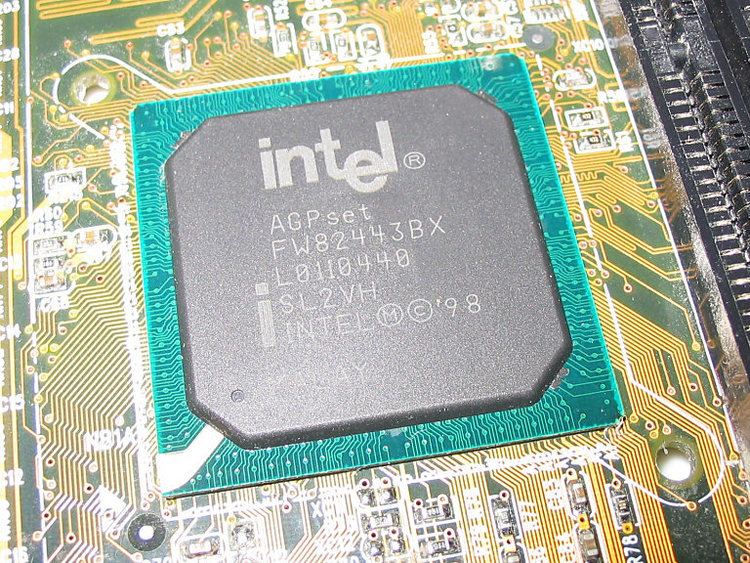 The Intel 440BX "Seattle" chipset was released the same year as this laptop, 1998. Bettering its slightly earlier 440LX, Seattle provided official support for a 100 MHz front side bus, and like the LX it also supported the AGP local bus for video as well as fast SDRAM memory.
The Intel 440BX "Seattle" chipset was released the same year as this laptop, 1998. Bettering its slightly earlier 440LX, Seattle provided official support for a 100 MHz front side bus, and like the LX it also supported the AGP local bus for video as well as fast SDRAM memory.
Sadly, none of these benefits of the BX over the LX were realised for our laptop here, since the Tonga CPU was hard-wired to only go up to 66 MHz FSB and the Tosh came with a PCI graphics subsystem.
On the plus side, we now know the Intel 440BX has a historical reputation for being a solid, highly-compatible chipset.
Memory
.jpg) The Satellite 4010CDT comes with a single 144-pin SODIMM (Small Outline DIMM) memory slot which is accessible underneath the keyboard. This slot is empty in an unexpanded 4010, as 32 MB of PC66 (66 MHz) non-ECC SDRAM is integrated onto the motherboard.
The Satellite 4010CDT comes with a single 144-pin SODIMM (Small Outline DIMM) memory slot which is accessible underneath the keyboard. This slot is empty in an unexpanded 4010, as 32 MB of PC66 (66 MHz) non-ECC SDRAM is integrated onto the motherboard.
Expansion options catered to bring maximum memory up to 160 MB with one 128 MB SODIMM. The chipset can handle up to 512 MB of SDRAM or 1 GB of EDO RAM, but of course in laptops it's also about the physical storage limitations/accessibility - the 160 MB limit for this Toshiba was plenty for 1999. Even a premium desktop PC in 2000 would have only come with 128 MB.
Accessing the memory slot under the keyboard is simple. The grey plastic strip above the top row of keys can be removed by gently pulling up on the far right-hand side. Once this is out of the way, the keyboard can be lifted out by pulling up from the top and toward the screen. Four locating tabs at the top and four at the bottom of the keyboard unit keep the keyboard in place.
Mine here is fitted with a 4-chip 64 MB SDRAM SODIMM from Micron Technology, bringing memory on this laptop up to 96 MB.
.jpg)
.jpg)
(Left) The SODIMM slot with module ejected, and (Right) the rearside of the SODIMM
When removing a memory module like this, be very careful with the white plastic clips that keep the memory in place. I applied a tiny amount of upward force to the top of the SODIMM while simultaneously gently pulling the clips to the side one at a time. The module is spring-loaded against these clips so will eject automatically.
This particular module is over-rated for the machine, as it's able to run at 100 MHz, but because of the soldered-in 32 MB on the motherboard only running at 66 MHz, this module will also be downclocked to run at the same frequency.
Graphics
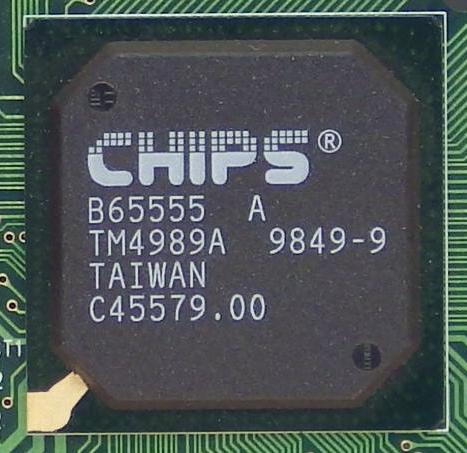 The Satellite 4000-series all came with the Chips & Technologies CT65555 graphics processor, branded "HiQVPro" by C&T. This ran on the PCI bus, so communicated with the CPU at 33 MHz. It supported hardware acceleration of things like BitBlt (Bit Block Transfers) including Transparent BitBlt, 24-bit color expansion, and also included hardware multimedia support including a zoomed video port, video capture and scaling,
horizontal and vertical interpolation and double-buffering.
The Satellite 4000-series all came with the Chips & Technologies CT65555 graphics processor, branded "HiQVPro" by C&T. This ran on the PCI bus, so communicated with the CPU at 33 MHz. It supported hardware acceleration of things like BitBlt (Bit Block Transfers) including Transparent BitBlt, 24-bit color expansion, and also included hardware multimedia support including a zoomed video port, video capture and scaling,
horizontal and vertical interpolation and double-buffering.
The chipset supported up to 4 MB of EDO video RAM, able to display resolutions up to 1280 x 1024 at 24 bits per pixel (16.7 million colours). The Toshiba here comes with 2 MB of video RAM, so resolution is limited to 800 x 600 at that colour depth using the built-in active matrix TFT display. If you connect the laptop to an external monitor, you can realise the full 1280 x 1024 resolution, but only at a 16bpp (bits-per-pixel) colour depth, due to the aforementioned video RAM limitation.
The fact this has a colour TFT display is critical - TFT active matrix technology provided much faster screen refreshes than passive matrix which was an important factor on any game that had fast scrolling. Passive matrix displays would exhibit an obvious 'blur' or 'shadowing' as the screen redraw was too slow to keep up with the machine, leaving behind several previous frame's images before it could be cleared. By contrast, active matrix screens eliminate this problem, plus they are much brighter and have a broader viewing angle.
The native resolution of 800 x 600 isn't ideal for DOS gaming since the majority of games ran at 320 x 200. Laptop displays usually scale this to fill the viewable area, and back in the late 90s they used techniques such as integer scaling and interpolation. Integer scaling uses a direct 2-for-1 (or more) scale, meaning a 320 x 200 image would scale 2:1 to fill a 640 x 480 area. On an 800 x 600 viewable area such as our laptop here, an interpolation or "stretch" mode instead would use a 2.5:1 scale, but since you cannot have half a pixel, it would attempt to guess what some of the pixels should show usually using 'nearest neighbour' calculation where an adjacent pixel's attributes would have a part to play in determining the colour of the one next to it. This would often end up with a less-than-ideal image on the screen. Laptops that used interpolation could typically be set back to integer scaling in the BIOS and this would result in a 640 x 480 image being displayed on the 800 x 600 screen with black bars down the sides and along the top and bottom. This is why I wrote in my DOS Laptops article that a 640 x 480 native display resolution is perfect for DOS, as it can use integer scaling to 640 x 480.
Having said all that, in 1999 we were running games in Windows, right? If so, the 800 x 600 resolution is much nicer here for Windows use, and whether you run a game in a window or full-screen they tended to support these higher resolutions anyway. The first game I installed on the 4010CDT was Blade Runner from Westwood Studios. This is a typical example of a Windows 95 game that runs in 640 x 480, though other titles in this era could be set to run anywhere up from 320 x 200 to well beyond the capabilitiy of this display, including a native 800 x 600. We'll get more into this is Part 2.
Storage
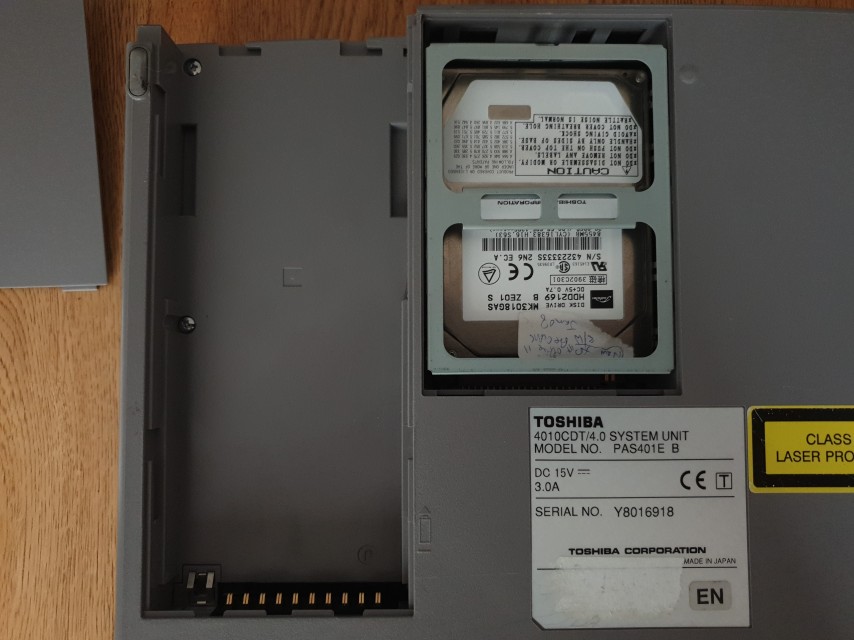 The Satellite 4010CDT came as standard with a 3.8 GB 2.5" IDE hard disk. The Intel 440BX chipset supports respectable IDE interface speeds of up to UDMA3 (33.3 MB/sec) or the slower PIO Mode 5 (22 MB/sec).
The Satellite 4010CDT came as standard with a 3.8 GB 2.5" IDE hard disk. The Intel 440BX chipset supports respectable IDE interface speeds of up to UDMA3 (33.3 MB/sec) or the slower PIO Mode 5 (22 MB/sec).
It was installed in a metal carriage, accessible under a trapdoor on the underside of the machine. A single screw that holds the trapdoor cover in place also keeps the carriage screwed down. Removing the carriage is easy - just lift from the front just enough so it clears the laptop's casing and pull forwards to release the hard disk from its slot.
This Toshiba Satellite 4010CDT has obviously had a hard disk upgrade at some point, as it has a Toshiba HDD2169, which is a whopping 30 GB in capacity. It's a hard disk that supports UDMA/66 which has twice the theoretical throughput of the original drive, though would be limited to 33 MB/sec by the 440BX chipset in our case.
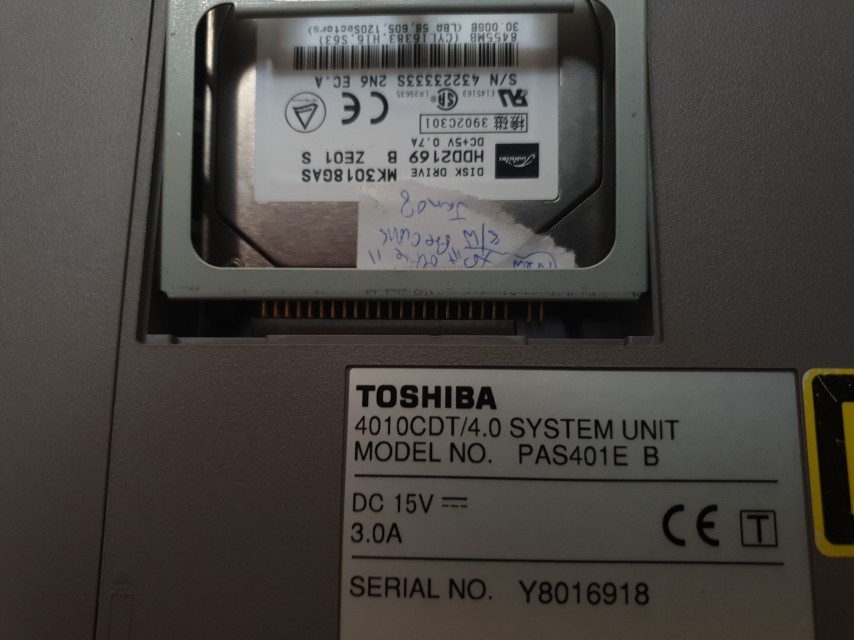
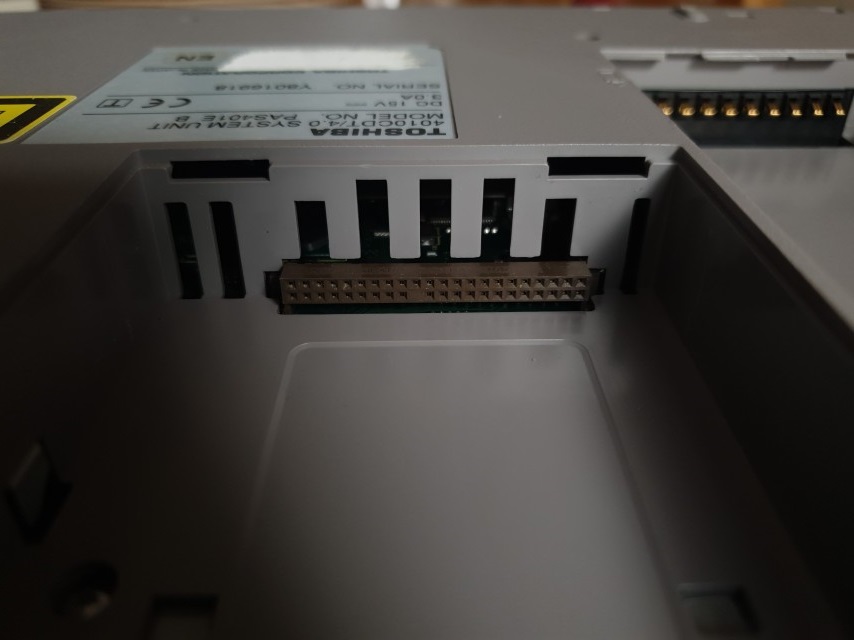
(Left) the hard disk being installed back in the bay, and (right) the IDE socket in the bay
In the left image above, note that the 4 pins (2x2) on the far right are not connected to the drive - the IDE specification for 2.5" hard drives allows for power to be provided via these pins, but I guess these Toshibas use other pins on the interface to get their power from instead.
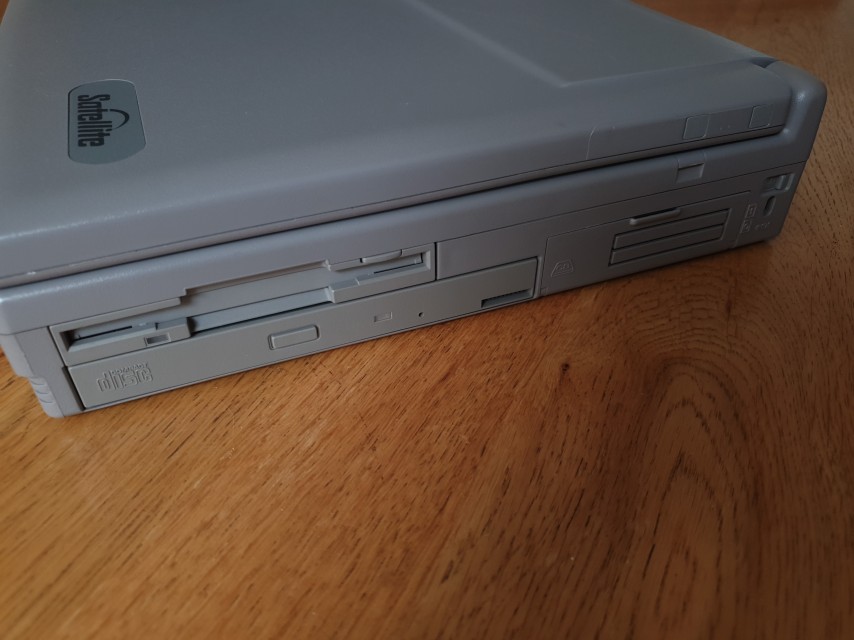 In addition to the hard disk, the Satellite 4010CDT came with an internal 3.5" 1.44 MB floppy drive and a 24x CD-ROM drive below it. Both of these are low-profile units, taking up less height than a 5.25" half-height bay (each drive is 12.5mm high). The CD-ROM is compatible with Kodak PhotoCD, CD-DA, CD-XA and CDi standards.
In addition to the hard disk, the Satellite 4010CDT came with an internal 3.5" 1.44 MB floppy drive and a 24x CD-ROM drive below it. Both of these are low-profile units, taking up less height than a 5.25" half-height bay (each drive is 12.5mm high). The CD-ROM is compatible with Kodak PhotoCD, CD-DA, CD-XA and CDi standards.
Both of these drives are not removable.
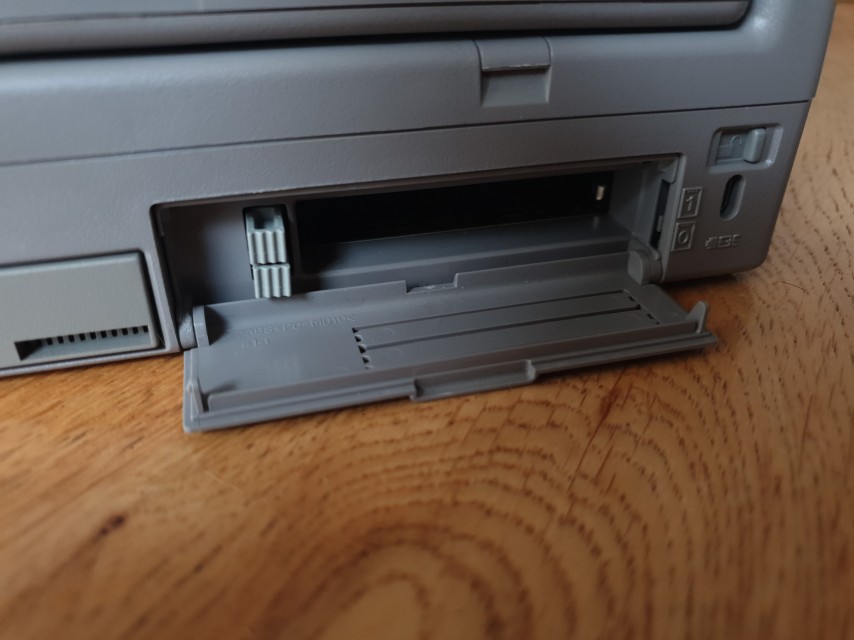 As was typical of laptops of this time period, it also came with a PC card slot, (previously called PCMCIA after the standard on which it was developed) - well actually there were two slots, depending on the type of cards being used. These were very popular in 1990s laptops and into the 2000s, offering a decent peripheral interface where previously there was none.
As was typical of laptops of this time period, it also came with a PC card slot, (previously called PCMCIA after the standard on which it was developed) - well actually there were two slots, depending on the type of cards being used. These were very popular in 1990s laptops and into the 2000s, offering a decent peripheral interface where previously there was none.
You could install two Type I or Type II PCMCIA cards, or a single Type III card. These slots are also compatible with the 32-bit PCI CardBus standard, and can be used to install memory, storage or communication devices such as a network card or modem. Solid State hard disk cards tend to be Type III, which are taller than Type I or Type II cards to fit more components in, whereas modem cards for example, were typically Type II.
Battery / AC Power
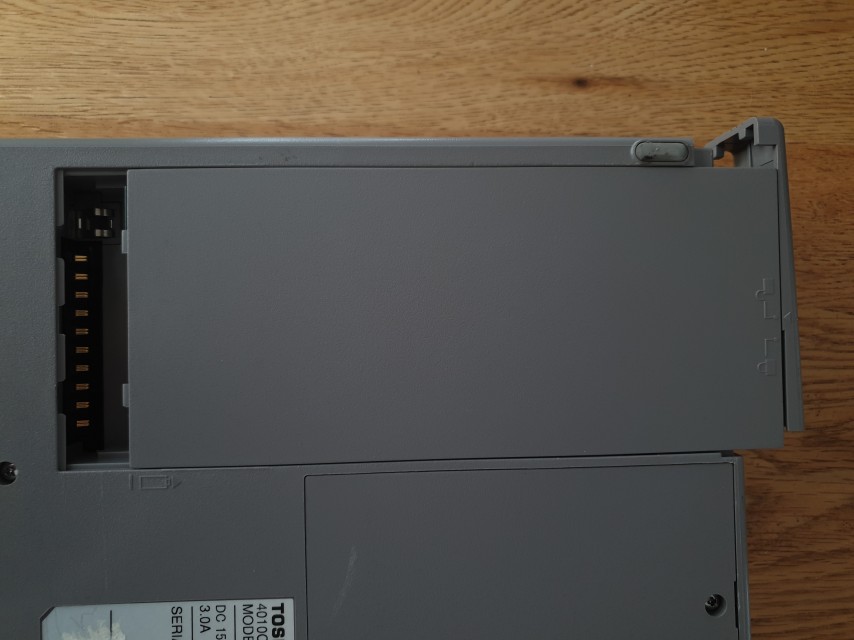 The 4010CDT comes with a 4000mAh Li-Ion battery pack (model #PA2487U), which when new would have been good for about 3.5 hours of runtime.
The 4010CDT comes with a 4000mAh Li-Ion battery pack (model #PA2487U), which when new would have been good for about 3.5 hours of runtime.
It provides 10.8V of DC voltage for the laptop, so without opening it up (they really don't like you opening these things - they're very much sealed units!) I would guess it comprises 9 individual 1.2V DC rechargeable cells inside.
Removal of the battery is extremely easy - just slide the tab on the corner of the laptop/battery outward and pull forward. Within the grey plastic housing is the battery itself.

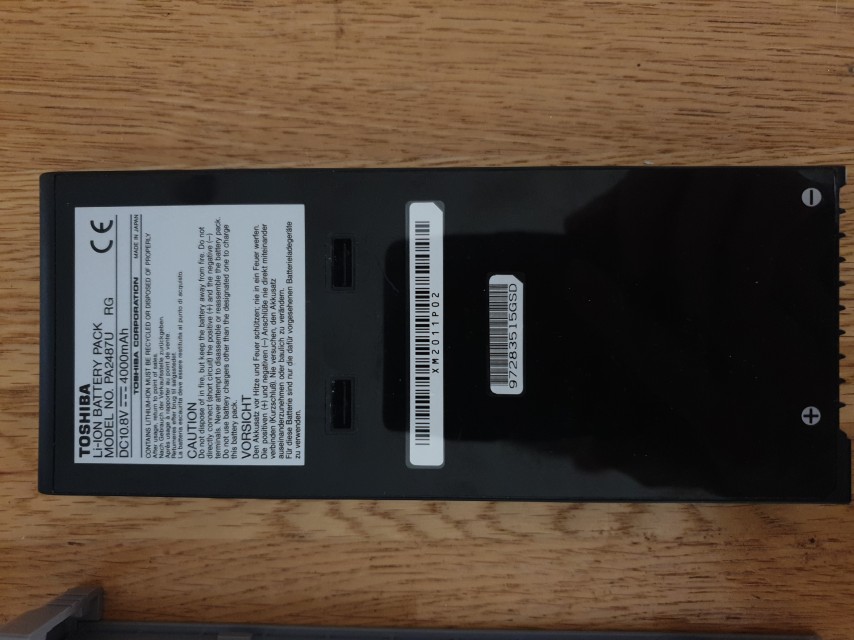
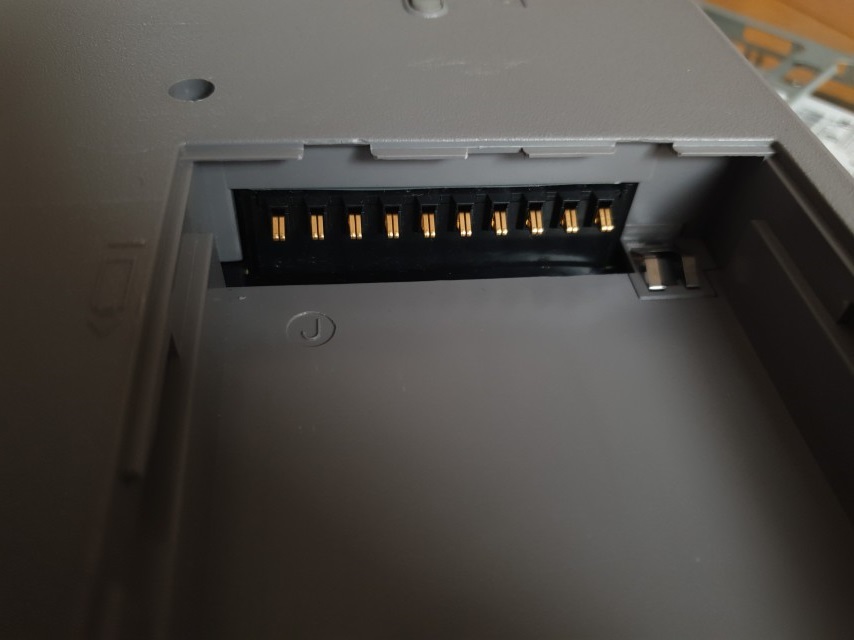
From left: the battery pack removed and flipped over, the battery itself taken out of its plastic housing,
and
the battery bay
I did shop around for replacement battery packs and came across some mad prices, like £128.61 with a further £5.99 shipping fee, though with a brief further browse I came up trumps with several compatible Toshiba batteries. The Toshiba PA3107U is a 4500mAh unit that cost just £59.61 - still not great, but you can understand the market for these is incredibly small these days. An even better deal was the compatible Toshiba PABAS011, which is a 4400mAh battery, coming in at £29.99 not including shipping (£5.99) - that is pretty tempting if you wanted to really use this thing on the road again. Sadly a lot of the stores that still advertise these alternative batteries (as well as a replacement original) are out of stock, so be prepared to have to crack open the battery case on the one you have to replace the cells. Personally I'm good with running it solely on the mains.
The external AC power supply provided with the laptop (model #PA2409U) provides 15V DC at 1.4 amps. It will happily accept an input voltage from 100V to 240V AC if you're importing one from abroad.
Even today, I was able to get about 1.5 hours of battery life from the original battery just running idle in Windows.
Keyboard
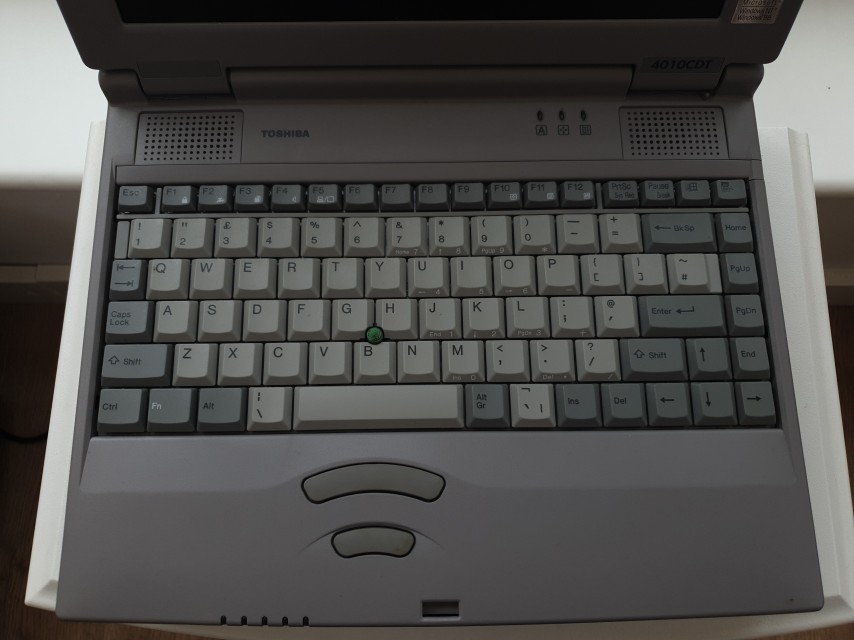 The 86-key keyboard on the Satellite 4010CDT is very comfortable to use, and has a decent amount of key travel and feedback. While not in the same calibre as something like the IBM Model 'M' clicky keyboard, it doesn't feel mushy to use - when a key is pressed you know it.
The 86-key keyboard on the Satellite 4010CDT is very comfortable to use, and has a decent amount of key travel and feedback. While not in the same calibre as something like the IBM Model 'M' clicky keyboard, it doesn't feel mushy to use - when a key is pressed you know it.
It is well laid out, though the space bar is a little on the small side. I assume this is because Toshiba were trying to fit lots of full-sized keys into a laptop that was actually quite narrow for its time. Some laptops had the INS and DEL keys in the top-right corner, but this Toshiba has the two Windows keys up there, and twelve keys were needed on the bottom row instead of ten. Still, I had no mis-keys when using this.
The Satellite 4010CDT has a built-in mouse which Toshiba called MousePoint with two mouse buttons, and this works well if you're used to using such a device. The actual mousepoint itself is pretty worn and dirty on this one, but replacements are cheap and easy to source.
Audio
 Above the keyboard are two speakers for decent stereo sound that comes from the embedded sound card chipset, which in this case is Sound Blaster Pro-compatible and has 3D surround capabilities.
Above the keyboard are two speakers for decent stereo sound that comes from the embedded sound card chipset, which in this case is Sound Blaster Pro-compatible and has 3D surround capabilities.
On the left side of the laptop you have three audio jacks, with line-in, mic-in, and speaker (or headphone) out, as well as a volume slider. The Line-in here is an especially nice touch.
I will cover more on this in Part 2, but in short, it's excellent for the time period, giving you the ability to play tons of games on the move with pretty decent audio quality.
Rear Ports
 On the rear of the laptop are the usual expected assortment of interface ports.
On the rear of the laptop are the usual expected assortment of interface ports.
From the left, we have:
* 15-pin analogue (RGB) monitor out
* 25-pin Centronics parallel port
* 9-pin RS-232 serial port
* Infra-red (IrDA-compatible) communications window
* USB 1.0 port
* PS/2 port (for external keyboard or mouse)
*
DC power jack
This covers all the bases you would need. Later laptops had all of these under a plastic pull-down cover, presumably to keep the dust out and make the laptop appear more clean, but it is what it is. The USB port strangely does have a plastic cover but the rest are exposed. The IrDA port was a thing of its time, when many of us had PDAs (Personal Digital Assistants), and infra-red was a common and easy way to transfer data between your laptop and your PDA by lining up the devices' infra-red ports within about 1 foot of each other - it was slow but worked well enough for small files. If memory serves these could run at up to 115,200 kbps.
As mentioned further up, attaching the laptop to an external analogue VGA monitor (or a multisync) provides the highest resolution the machine is capable of - 1280 x 1024 in 65,536 colours - or if you want to have 16.7 million colours on-screen, a resolution of 800 x 600 (the same as you would get from the built-in TFT panel). Of course, this laptop ran at a time where the 4:3 aspect ratio was standard (hence 800 x 600 = 4:3), and the 16:9 we have today was limited to the cinema.
Let me know if you want to see more of this laptop - if there's enough interest I'll extend this article with some videos and you can see it in operation.
Downloads
If you happen to own a Satellite 4010-series laptop, the following downloads might be useful to you:
Toshiba 4010-series Flyer The original 2-page flyer for the Satellite 4010CDS/CDT.
|
TSETUP BIOS/CMOS Setup This DOS program displays and allows you to set the CMOS/BIOS settings of your Toshiba portable computer. This program does not run in a DOS session under Windows. From Windows, you'll need to restart in MS-DOS mode in order to use this utility.You can also access the BIOS/CMOS setup screen without having to use TSETUP by holding down the [Esc] key when you first power-on the system.
|
DMI Update Utility This Utility will eliminate the "Wrong machine" messages when you try to restore the factory software image from the Config Builder CD or PIRAD CD/DVD.Requires either a bootable diskette drive (FDD), or bootable CD-ROM (CD-RW, DVD-ROM/RW). If no FDD is available, requires access to CD authoring (burning) software and hardware.Build 60303 fixes an issue where Satellite 5205-S705 units were programmed with the incorrect DMI model string. |
ACPI Flash BIOS |
ACPI Flash BIOS |
ACPI Flash BIOS |
ACPI Flash BIOS |
ACPI Flash BIOS
|
ACPI Flash BIOS Power management controlling power consumption and temperature has been improved. |
ACPI Flash BIOS A change was made to correct a problem that some PC cards with a single spec for 16-bit and 3.3VDC may malfunction. |
Win9x Audio Quick Fix Fixes a problem to allow the playing of an audio CD when the system is in battery mode. |
Win9x OPL3-SAx Sound Driver Windows 95/98 Sound driver version 4.06.2343.VCN-RC2 for Yamaha OPL3-SAx sound systems. This release fixes a GPF when repeatedly opening and closing AVI files. |
Win95 Display Driver Windows 95 Display Driver version 3.0.8.2 for C&T 65555 display adapter. |
Win95 Infrared Driver Toshiba Infrared Driver version 1.10 for Windows 95. Allows use of PCI-based Infrared port with Windows 95 4.00.950B (OSR2) Infrared. |
Win9x Hibernation Utility Toshiba Hibernation Utility version 5.0 for Windows 95/98. Updated to support Win98 SE. |
Win9x Mouse Control Toshiba Mouse Control (drivers) version 2.5.2 for Windows 95/98. |
Win9x/NT Modem Drivers for 3Com 56K PCMCIA Modem Windows (95/98/NT) Modem Drivers version 1.0.04 for 3Com Noteworthy 56K (3CXM056-BNW) PCMCIA modem in Satellite 4000C Series. |
Win9x/NT/2000 TBios Driver This driver exposes system information to DMI-enabled applications. |
Win9x System LED Application This software is an optional system component that displays system LED icons for Toshiba notebook computers. |
Win9x Online User's Guide Toshiba 32-bit (Win9x) Online User's Guide version 1.1 for Sat 4000. |